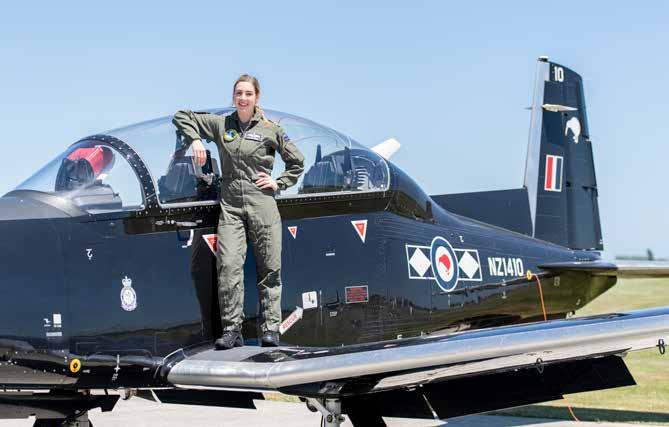
23 minute read
First female helicopter pilot
Leaping from the bridge to a waiting helicopter
Lieutenant Jo Brook didn’t think she would be breaking new ground when she eyed up a switch from the bridge of a warship to helicopters. But the 27-year-old from Dunedin will soon go in the books as the Royal New Zealand Navy’s first female helicopter pilot. She graduated from her Wings course at the end of January and is about to start helicopter training with No. 3 Squadron. It’s another sea change for LT Brook, who joined the Navy in 2014 after deciding a double degree at Otago University wasn’t doing it for her. “I needed to find something with a more practical edge. I’d often toyed with the idea of joining the military, but I’d always considered it something of a pipe dream. “It wasn’t until I spoke with my family about one of my childhood friends joining the Army that I started seriously considering the military.” Her role as a warfare officer took her all around the South China Sea, Australia and the South Pacific. She was serving aboard HMNZS CANTERBURY in the South Pacific, near Vanuatu, at the time and the embarked aircrew offered to take her on a helicopter flight. “We flew around some of the islands at low level, nearby one of the active volcanoes... I thought it was just the coolest thing I’d ever done.” She was hooked, and as part of her new piloting career spent three months in the United Kingdom on a course – visiting four different squadrons for flights on helicopters and training aircraft, and helping organise one of England’s biggest air shows. She is most looking forward to lowlevel flying exercises. “We can fly down to quite a low level in the Texan, but in the helicopters we’ll be basically brushing the tree tops with the rotor blades.” She wasn’t aware she would be the first female naval helicopter pilot until she applied. “The bigger achievement is getting my wings, not being the Navy’s first female helicopter pilot. “I don’t think I’ve ever been more relieved in my entire life to finally hear my checking officer tell me ‘congratulations, you’ve passed’. “I never considered in high school that I would ever be selected as a military pilot. I thought that because I wasn’t getting top marks in maths and physics, I would never make it through. “It took me a while to figure out that I could get good marks in those subjects, I just had to work a bit harder and want it more.”
Advertisement

MATATAUA in Tokelau
Is a runway on Tokelau feasible? The Government turns to HMNZS MATATAUA to help investigate whether that’s possible.
While over 200 personnel aboard HMNZS CANTERBURY were dealing with an infrastructure delivery of solar panels and water tanks to the three Tokelau atolls in November, a quiet team of six hydrographers were helping to prove future access routes to the remote isles.
Military Hydrographic Group Team 2, led by Lieutenant David Jaquiery, was given two jobs. The first was traditionally aligned with HMNZS MATATAUA’s military role – investigate and chart the sea approaches to each atoll, up to the beach. “You have to appreciate the topography in Tokelau,” says LT Jaquiery. “The atolls drop off really quickly, about a hundred metres out. But close in, we wanted to know, can we get one of CANTERBURY’s Landing Craft up the channels, to the shore? Can we get RHIBs in there? These are things we need to know because we want to be as prepared



as we can. If we get asked to support Tokelau in a Humanitarian and Disaster Relief situation, we want to know our options.” The other task was a role normally reserved for professional land surveyors. The team were asked to provide topographical data for areas being considered as a possible runway site on one of the atolls, Nukunono. At present none of the atolls have landing capacity, making the small country only reachable by ship from Samoa. “Dealing with beaches is pretty normal for us. But this work, for the Ministry of Foreign Affairs and Trade, was quite unique. They wanted to know, how much material would they need to bring in, to bring the land up to a certain height above sea level.” To do that, the MATATAUA team had to provide a topographical survey map, showing spot heights above mean sea level across each site mooted as a possible airstrip. It’s not as easy as it sounds. GPS surveys can provide spot latitude and longitude positions and heights based on a mathematical definition of the surface of the earth – the WGS84 spheroid. However, that standardised surface is not the same as mean sea level. The separation between the two can be found through matching GPS positioning with tidal observations, where the tidal rise and fall can be measured to find the mean sea level and its height on the spheroid. The difference is then applied to achieve a geodetic topographic survey accurate enough for engineering assessment. “We only had three days to spend on it and it got quite challenging,” says LT Jaquiery. “We weren’t able to put a tide gauge in close proximity, and you really need both, because the lagoon is effectively a different tidal region. It did introduce an error, but this was meant to be a preliminary assessment.” The conditions were arduous, with 30-plus degree temperatures while wearing PPE. “It was quite hard working in mask and gloves, and we had to move a lot of the equipment around on foot. Normally we would have stayed ashore but COVID precautions meant that wasn’t possible. So we would come to the island each day, launch our boat and haul it ashore at the end of each day.” But it went well, he says. “We rose to the challenge. It was a great opportunity to show off what we can do, even in a COVID environment.”



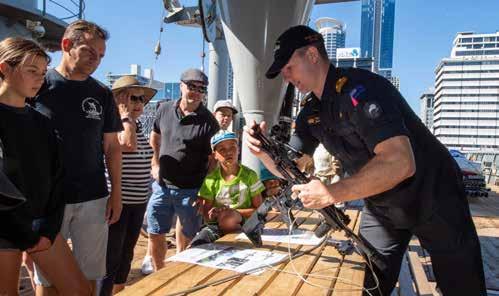
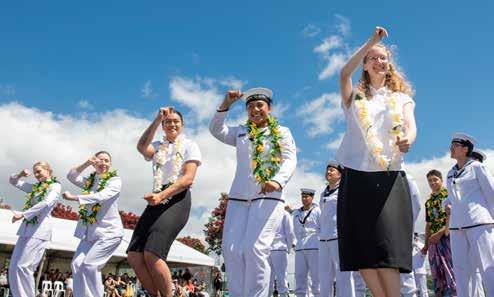
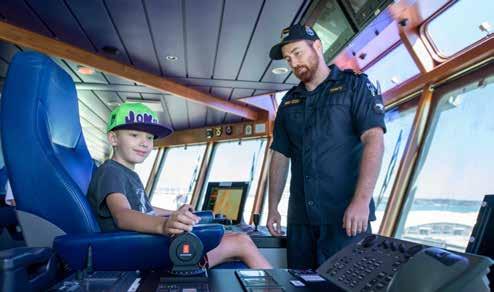

8
10 6



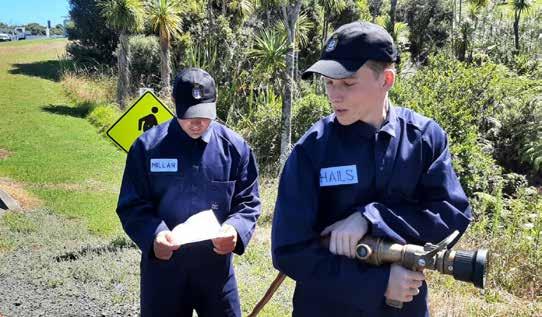
Our People
1. AMT(L) Daniel Bowler enjoys a sunny Auckland Anniversary during the Seeport Festival. 2. HMNZS MANAWANUI wins the Champion of the Navy award, with LMED Max Neustroski (middle) and SLT Rebecca Smeele collecting the life ring at the Bravo Zulu Awards.
3. WOCH Steve Bourke is promoted to Lieutenant by BRIG Rob Krushka and former Chief of Navy, RADM John Martin. 4. POMUS Seleni Sulusi teaches CDRE Melissa Ross a few drum moves. 5. LT Matt Barnett assembles a MARS-L rifle on the cargo deck of HMNZS MANAWANUI during a Ship Open Day at the Seeport Festival, Auckland. 6. CDRE Melissa Ross, Deputy Chief of Navy, reviews the assembled trainees of BCT 20/02 at their graduation ceremony in December. 7. CDR Kerry Tutty, newly posted as Commanding Officer Leadership Development Group. 8. Members of the Navy’s Pasifika Choir perform at the BCT 20/02 graduation. 9. Midshipmen Elliott Millar and Elliot Hails come to grips with firefighter training during the JOCT 21/01 course at Tamaki Leadership Centre. 10. SLT Samuel McMinn supervises an eager visitor to HMNZS MANAWANUI during Auckland’s Seeport Festival. 11. POET Matthew Hudson works with Y13 students during the Navy’s School to Seas programme at Devonport Naval Base.
Getting to grips with a ship’s routine
Sub Lieutenant Grace Russell
It can be daunting posting to a ship for the first time, and Sub Lieutenant Grace Russell, fresh from JOCT graduation last year, didn’t want to be a nuisance in her new posting in HMNZS CANTERBURY.

But with ‘initial sea time’, the nuisance factor is almost guaranteed. New officers spend their first four weeks in every department on ship, finding out how they work. And CANTERBURY, busy as she was with exercises and the Tokelau infrastructure mission in November, was the perfect place for a young engineer to find her routine. “I was worried about being a nuisance, being in different places, changing what you do each day, and asking lots of questions. The ship has a routine of its own, and it’s hard to find your feet. But the people are lovely, really helpful.” Initial Sea Time requires new officers to spend a week with each department. If I’m going to be leading people, I need to understand what they do. I need to know what it’s like to be in the galley, to be up at five o’clock, standing over a hot oven all day, and then finding out why it’s annoying when 200 people ask me how many chicken drumsticks they can have.”
Following this, SLT Russell works with engineers on specific duties, then will be posted to an engineering job and await her turn on an overseas engineering course. “It’s an awesome programme to do and perfect in terms of learning. COVID has been hard in some ways, to get things organised, but that’s the whole country.” COVID-19 had a big impact on her officer training, as it ran through the Level 4 lockdown. “I really struggled with that. The week before lockdown, we had so much to do. Then the whole country went into lockdown, and no-one could come in to assess you. We put two weeks of effort into our kit muster, and there’s no-one to count the creases in your shirt. Admittedly, it did mean no-one could tell how well you had ironed your kit that day.” SLT Russell, who is from Palmerston North and Amberly, was inspired to join the Navy because she got to tackle ‘real’ problems. She joined via the Chatham Scheme, which involved joining the Naval Reserves and getting a small living allowance while she studied engineering. “I’ve always enjoyed solving problems and fixing things. Seeing how and why things work. When I read about it, it looked like it was going to be behind a desk, handling paperwork and similar problems each day. But in the Defence Force, the problems are more real. You’re on the move, in coveralls most days. That’s what drove me.”
Spick and Span
Maintaining a tidy and orderly environment is part and parcel of a sailor’s working life.
It’s an ethic that’s taught early on in training, as shown here with these images of Junior Officer Common Training intake 21/01 at Tamaki Leadership Centre, Whangaparāoa Peninsula.
The rounds conducted by the Officer Training School Officer (OTSO) – in this instance, Lieutenant Commander Scott McGregor – are the first formal rounds by a senior officer to check the midshipmen’s standards. “It’s a large area to cover,” says Lieutenant LJ Littleton, the JOCT course officer. “It’s the dining hall, classrooms, accommodation block, laundry, boot locker, heads and showers.” In fact, the midshipmen have been working on their routine for two weeks and have experienced numerous rounds with their instructors. “The OTSO’s check isn’t really about picking up things that are wrong,” says LT Littleton. “OTSO’s staff are the ones that ensure the trainees are up to standard. We’ll provide the remedials (tasks to complete to reinforce the correction). By the time OTSO walks through we, and more importantly the trainees, are ready for it. OTSO’s rounds are a chance to catch up with the trainees, ask them how the training is going and check the morale.”



Clockwise from top: Three midshipmen stand at ease while LTCDR McGregor looks over their racks.
A well-kept set of lockers. LTCDR Scott McGregor talks to a midshipman as she awaits a review of her accommodation area.
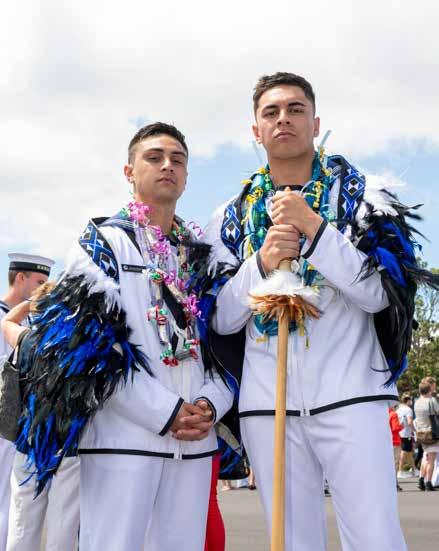
Rotorua brothers began Navy legacy for family
In the wake of a tourism downturn in Rotorua, two brothers have moved from a performing arts family business to embrace careers in the Royal New Zealand Navy.
Khan and Bodean Raharuhi, Te Arawa, 21 and 19, graduated together from the 16-week Basic Common Training course at Devonport Naval Base in December, among a class of 88 trainees. It was a proud moment for Khan, who led the Navy haka for his graduating class with skills honed at the Mitai Marae Village, his family’s business. The pair are the oldest of five brothers and are very aware they are setting an example for their siblings and wider family. Khan had also been working as a tour guide at Rainbow Springs after finishing at Western Heights High School, but had wanted to join the Navy since he was a teenager. The pair love the sea and are strong surfers. “I had been doing applications for a while, but I didn’t get properly into it until I was 20.
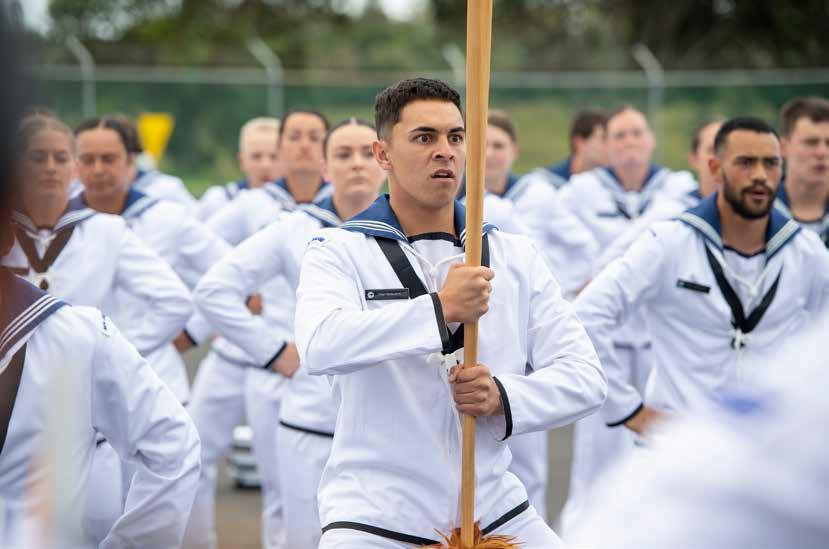
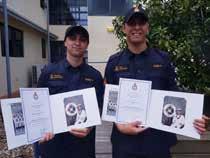
What pushed me was having a son. I thought, I needed to do something, to create a legacy for my family.” Bodean followed his lead, and the pair did a police preparation course at Toi Ohomai Institute of Technology to prepare them for the rigours of Navy training. They started in August, just as Auckland went into Level 3 lockdown. It meant the trainee entry into Auckland had to be carefully managed, with buses delivering recruits to the base. The brothers were fit, but there was homesickness. “You make a lot of friends in training. They know what you’re feeling, because it’s the way we’re all feeling. Mail from my parents helped me through, and having my brother there was great. But there are so many highlights, so many new things we’ve learnt.” Bodean says he kept himself on track by thinking of his family and the future. “My brothers, they’re looking at us as big role models. We didn’t want to let them down.”
He enjoyed some of the toughest parts of the course, such as ‘Shakedown’ Week which tests trainees’ endurance. “You think you’re slowly improving, but during those weeks you see this massive difference, compared to how you were at the start. It makes you feel good.” Bodean and Khan say they are excited about starting their trade training next year in the Seamanship Combat Specialist role. These are the experts in seamanship operations, including gunnery, seaboat operations, boarding of vessels and ship security. Khan’s advice to others is to give it a go. “It’s an amazing experience. You’re doing things very few people get to do. I’m hoping some of my family follow in my footsteps.” Bodean says it might be tough at first, but it gets way better. “Just go hard. You feel good about yourself. You feel proud.”
~ OSCS Khan Raharuhi
Science & Engineering
Preparing us for the future
Who provides the science and engineering knowhow behind the Royal New Zealand Navy fleet? RNZN Chief Naval Architect Chris Howard explores the Navy’s partnership with the Defence Technology Agency (DTA).
From left to right: Selfie by Chris Howard on HMNZS WELLINGTON.
Ice coats HMNZS WELLINGTON in the Southern Ocean as DTA undertake an icephobic coating trial. Experiments with anti-fouling paint in ‘stripes’ on the underside of a vessel. DTA investigation of broken turbine blades from HMNZS CANTERBURY’s engines. A safe and capable fleet owes a lot to technology. In New Zealand’s case, these gains are made through the collaboration and combined expertise between RNZN naval engineering and DTA.
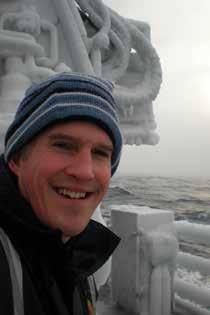
DTA is made up of about 80 civilians who add a depth of scientific expertise and understanding to where it is needed across the NZDF. This includes assisting the Chief Naval Engineer, Captain Richard Walker, and his team, the Naval Engineering Authority (NEA) to be an intelligent engineering customer for future vessels, and to address challenging in-service technical issues. This partnership encompasses a range of specialist domains including platform engineering, materials engineering, environmental science and human systems. The resulting science supports important outcomes for Navy.
Understanding the science of Southern Ocean waves
The Southern Ocean, off New Zealand, contains some of the world’s roughest seas. This clearly has big implications for the design and operation of RNZN ships. However, until recently, the sparsity of shipping in these waters meant that actual wave conditions were not well measured, and wave/weather models were poorly calibrated. This has been addressed by DTA through an ambitious programme of data capture from wave buoys deployed south of New Zealand. The clever bit from this is that DTA (in collaboration with others) has managed to produce a vastly improved statistical picture of these sea conditions. This ‘wave atlas’ defines the sea conditions we can expect RNZN ships to encounter, including extremes that ships must survive. (The largest wave height so far recorded in the Southern Ocean is 23.8 m!) This data is now used to set better seakeeping requirements for the design and operation of future RNZN ships. Ultimately, on the back of this work, the design requirements will better match the actual conditions.
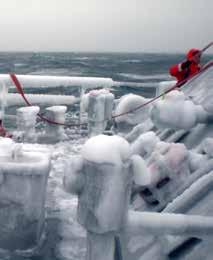
Re-thinking biofouling management
The Navy has long used antifoul paint on ship hulls to help control marine growth that adversely affects performance and fuel economy. However, the primary driver for this has recently shifted. We must now meet new, and much stricter, biosecurity requirements to prevent the spread of potentially invasive marine pests into and around New Zealand. To comply, it initially seemed that the Navy would require a burdensome regime of ship in-water cleaning and dry-docking. However, thanks to a programme of DTA experimentation, a better solution has been found. Independently evaluating the performance of many alternative anti-foul coatings, a modern commercially available coating was identified that is very well suited to most RNZN ships and operating conditions. The Navy has updated its paint specifications and policies accordingly. Importantly, we can now comply with the strict new biosecurity requirements without a need for continuous hull cleaning, while still seeing the performance benefits.
What else?
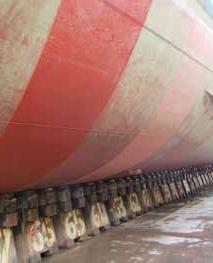

Other examples of reward from applied research are: • DTA metallurgists and engineers providing advice that seeks to slow the tide of corrosion and structural fatigue that can ultimately lay waste to a naval ship. • Advice from DTA fuel specialists and fuel quality testing which assures that our engines will keep turning. • Getting to the root cause of mechanical failures.
• Human factors, notably the human-machine interface, being treated as integral to ship design, such as with the layout of the recently upgraded Anzac frigates’ Operations Room. DTA also does ship monitoring and data acquisition work that enables vast amounts of ship sensor data to be captured from ships at sea (the easy part), through to making intelligent decisions from it (the harder bit). In future, the data could provide operator guidance and monitoring of ship operation that helps to quantify and minimise RNZN greenhouse gas emissions. Recently, we have used such systems to capture data towards validating the seakeeping performance of our ships, and better understanding operational limitations. This included a seakeeping trial of HMNZS CANTERBURY in July 2019, involving both DTA and NEA personnel, that enabled more accurate modelling of her performance in rough seas and ultimately, led to a relaxation of her operational restrictions in high sea states. DTA is helping the Navy maintain an eye to the future – preparing naval engineering for the Navy after next. However, DTA does not always have all the answers in-house. Instead, together with the NEA, it makes use of strategic relationships and networks, including partner Navies, academia, and industry. The NEA is able to directly exchange technical information with its ABCANZ (AmericanBritish-Canadian-Australian-NZ) naval counterparts for areas such as Ship Materials Technology, Survivability, Hydromechanics, Fuels and Structures. Similarly, DTA has formalised relationships with these same countries through The Technical Cooperation Program (TTCP) of government defence research agencies, where specialist collaborative research and information exchange takes place. These relationships help Navy stay on the front foot with changes to technology. For example, the RNZN fleet is gradually transitioning from camouflage grey polyurethane naval topside coatings, to a much more resilient polysiloxane-based, haze grey paint system that was developed by the Australian Defence Force and their Defence Science Technology Group. As a relatively small defence force, the NZDF can utilise its organisational agility to enable technology trials. For example, RNZN Offshore Patrol Vessels have tested US Navydeveloped novel icephobic coatings at sea, in Antarctic waters. Such NEA-DTA work is challenging and rewarding. For the interdisciplinary team of scientists and engineers that work together the science can be fun, as well as clearly purposeful, with their work contributing long term safety and capability benefit to Navy.

Honorary Captains
Professor Stephen Hoadley PhD Honorary Captain since 1 October 1998
My contribution to the NZDF began with invited lectures on international affairs to the Command and Staff College, then of the RNZAF at Whenuapai, in the 1970s. Two decades later I was named an Honorary Professor of the College, now a triservice institution located at Trentham Military Camp, and two decades after that, in 2019, a classroom was named for me, the Hoadley Room. Meanwhile the Royal New Zealand Navy had recruited me to deliver modules on politics, international relations and security to Navy midshipmen in the Junior Officer Common Training cohorts twice a year. This was extended to twice yearly modules for chiefs preparing for promotion to Warrant Officer. During this time I had the opportunity to meet a succession of commanding officers, commodores-Auckland, and Chiefs of Navy, less for my own social virtues than for those of my wife Wyn who was a city councillor, then mayor, of Takapuna. Furthermore, we encouraged our daughter Jennie to join the RNZNVR. She subsequently proceeded from boot camp to officer rank, then to Commanding Officer of HMNZS NGAPONA, and then to Naval Staff under RADM John Martin and Institute of Leader Development under RADM David Proctor, now with a regular Navy rank of Commander. During the past decades I had also been active as a media commentator and public speaker with a reputation, I believe, for fairness and balance toward the Defence Force, in contrast to prominent critics of the military profession and armed preparedness. I wrote a book entitled New Zealand United States Relations (2000, rev 2017) in which I reviewed defence cooperation sympathetically at a time when public anti-American, antinuclear and anti-war sentiments ran high. Appointment to government advisory committees on topics such as aid, arms control, and intelligence, and invitations to briefings by the Navy, NZDF, Ministry of Defence and Ministry of Foreign Affairs, and encounters with MPs and ministers, kept me not only informed of defence and security policies but also respectful of the quality of those men and women who made and implemented them. I believe it is for these reasons that in 1999, Rear Admiral Fred Wilson, then Chief of Navy, and Commodore Peter McHaffie, Commodore Auckland, invited me, Wyn, and Jennie to the PHILOMEL Officers Mess to receive the appointment as Honorary Captain. Since then I have continued, by lectures to officers and commentary to media, as well as through my academic lecturing and writing, to report fairly and objectively on the initiatives and actions of the uniformed personnel who staff, and the civilians who support, the New Zealand Defence Force, and particularly the Royal New Zealand Navy.
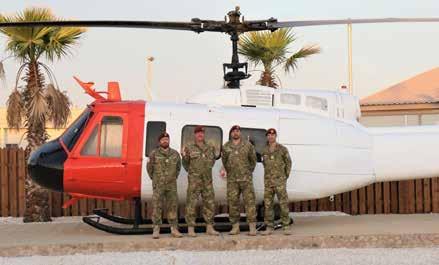
From left, LEWS Daniel Lord, CPOWTR Bart Couprie, POMT(L) Stace Greer and CDR Rob Welford, with a UH-1, ‘Huey’ helicopter formerly used by the MFO, on display on the Parade Ground at South Camp.
Sailors in the Sinai
By CDR Rob Welford
Bringing your Navy skills to an operation doesn’t always mean being at sea. The Royal New Zealand Navy is currently contributing four staff to the latest rotation of peacekeepers in the Sinai Peninsula in Egypt, as part of the Multinational Force and Observers (MFO). Operation Farad, as the deployment is known, involves 30 New Zealand Defence Force peacekeepers. It’s mostly Army, with four from Air Force, and four Navy personnel. After a period of routine quarantine, on entry to Egypt, Commander Rob Welford, Chief Petty Officer Writer Bart Couprie, Petty Officer Marine Technician (Electrical) Stace Greer and Leading Electronic Warfare Specialist Daniel Lord started their MFO duties in the second week of November.
The origins of the MFO lie in the 1979 Treaty of Peace between Egypt and Israel, which was brokered by US President Jimmy Carter during the preceding Camp David talks. The two Treaty parties, Egypt and Israel, undertook to request the United Nations to provide a force and observers to supervise the implementation of the Treaty, but when this was not possible, they negotiated a further protocol establishing the MFO “as an alternative” to the envisioned UN force. The protocol was signed in 1981, and the MFO was established on the 25 April, Anzac Day, 1982. Since then, New Zealand has contributed Defence Force personnel to the force continuously. Command of the force rotates between nations, and the current commander is Major General Evan Williams, NZ Army. Navy personnel bring their specialisations to the mission. CDR Welford, a Warfare Officer, is employed as the Force Commander’s Executive Officer in the Headquarters at the MFO’s South Camp near Sharm El Sheikh, responsible for management of the Commander’s programme, and coordination of staff effort in support of the force mission. CPOWTR Couprie, a Personnel Administration Specialist, is responsible for the New Zealand contingent’s administration, documentation and financial aspects. POMT(L) Greer is employed as the camp electrician, supporting domestic appliances and infrastructure for the whole base. LEWS Lord is an analyst in the information cell, collating information from within the force, as well as external sources, to provide briefing material and assessment to inform the planning and conduct of operations. On a day-to-day basis, the mission of the MFO is to Observe, Verify and Report (OVR) military and troop dispositions in the Sinai Peninsula and the areas adjacent to the International Border Line in both Egypt and Israel. The Force also plays a significant role in facilitating dialogue between the Egyptian Armed Forces and the Israeli Defence Force. In practical terms, most of the OVR mission is conducted by the Civilian Observer Unit, with security, transport, planning, and logistical support from the military contingents, although it is emphasised that every member of the MFO is an ‘observer’, and the ability to recognise both Egyptian and Israeli military equipment is a core skill that is trained and practised regularly. Similarly, the Facilitation mission is conducted by providing planning, security, transport (including fixed wing aircraft and helicopters) to shuttle Treaty Partner representatives and VIPs between the two countries, and also to host meetings and dialogue at ‘neutral’ MFO bases and facilities.
Given that in the 30 years preceding the Treaty of Peace, Egypt and Israel had fought four wars, but in the 38 years of the MFO there has been peace, the MFO mission is, arguably, one of the most successful peacekeeping missions ever. Whether or not that particular claim is true, there is no doubt at all that the MFO has played a critical role in maintaining stability in the Middle East, and that the NZDF contribution has made a significant difference. As their predecessors have been, and their successors will be, the four sailors deployed today are proud to be playing their part as ‘Servants of Peace’.








